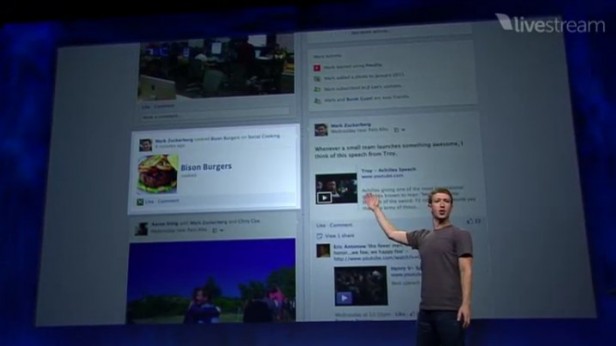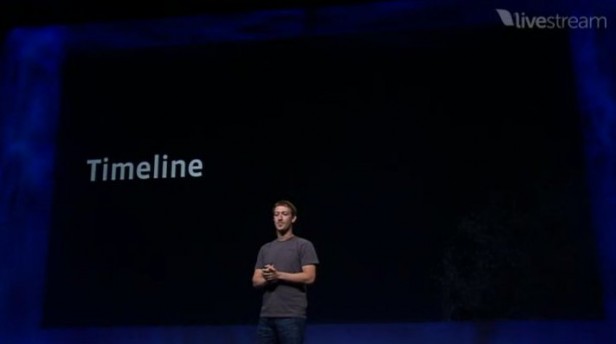f8, Facebook’s annual Developer Conference, took place today and I spent the morning listening to the keynotes on the livestream. Lots more change is coming to Facebook. (Don’t panic!) I’m excited about what I’ve seen so far and the potential for users to have a more engaging experience. Let me walk you through what I learned:
Facebook is going to shift its focus from getting people signed up to getting them better connected with one another. As Mark Zuckerberg stated, “Social networks are a ubiquitous tool used by billions of people. These networks are here to stay.” Now that the connections are in place, the next few years are going to be about enhancing the ways we can interact and engage online and developing the apps that make it possible to share more easily.
For me, the groundbreaking change is the complete revamp of the profile and the launch of Timeline, a tool that allows you and your friends to explore not just what you shared today but your past activity on Facebook as well. For users like me with years worth of data on Facebook it’ll be a wonderful trip down memory lane to be able to see our lives in review at the click of a mouse. Again quoting Mark Zuckerberg “Millions of people have spent years curating the stories of their lives and there’s no real way to share them.” Timeline will change that for the better. (And maybe for the worse … I wonder what content I shared when I first started on Facebook in 2006 or 2007 – I was a sleep deprived new Mum at the time!)
Timeline is all of your status updates, photos and videos you’ve shared and other activity that expresses who you are. Most users won’t want to show just what’s recent nor do they want to share every little thing so Timeline is designed to summarize your activity for you with more compressed highlights the further back in time you go. At a glance your Timeline will tell the whole story of your Facebook life not just what interested you today. It’s a reverse chronological representation of you, as the Wall has been, but enhanced with rich media for a more aesthetic experience.
 Users will be able to navigate each Timeline using a simple system of dots. Blue dots are highlighted events that appear on the new profile page while grey dots are for less important things. Click on any date to go back in time. It seems like an intuitive way to time travel – pick an event you want to revisit or select a date at random. You’ll also be able to filter what type of content you see – focusing on just photos or just a map view of places you’ve been.
Users will be able to navigate each Timeline using a simple system of dots. Blue dots are highlighted events that appear on the new profile page while grey dots are for less important things. Click on any date to go back in time. It seems like an intuitive way to time travel – pick an event you want to revisit or select a date at random. You’ll also be able to filter what type of content you see – focusing on just photos or just a map view of places you’ve been.
Perhaps best of all, we’ll now be able to add to our life story by filling in content from the past – baby pictures, school events, weddings, parties – anything that happened before your life on Facebook or is missing from your years of sharing can be added to your Timeline. The scrapbooker in me is very excited about the potential of this tool not only to tell my story but to make family history available as well in an interactive, shareable format.
Beyond Timeline, Facebook also announced their commitment to working with developers to create apps that will help us share on Facebook. Users can decide what they share from cooking apps, running apps, etc. And these apps will be designed with the tools to share your activity on your timeline without cluttering up the Newsfeed with a detailed account of every dinner you cooked this month.
 Depending on users interests we’ll all be able to add app boxes to our profile page that allows us to share what’s most important to you.
Depending on users interests we’ll all be able to add app boxes to our profile page that allows us to share what’s most important to you.
 As part of these developments, users will now be able to get a summary report of specific kinds of activity each week, month or year. For example, runners could get a tally of their total kilometres run with a map that shows where they ran to in a given month. Great for training and, I’d guess, motivating.
As part of these developments, users will now be able to get a summary report of specific kinds of activity each week, month or year. For example, runners could get a tally of their total kilometres run with a map that shows where they ran to in a given month. Great for training and, I’d guess, motivating.
Getting apps into your Timeline will be a simple matter. As you discover apps of interest anywhere in Facebook, you simply click to add the app to your timeline, give it permission to interact with your profile and it’s there. It’s a one time process that seems sleek and efficient. There’s no longer a need to approve every little update. “App discovery” will largely happen in a viral way as you see friends using apps that also interest you.
Another big change is a simple one – the Cover Photo. This is a big photo that appears across the top of your profile in addition to your profile picture. At a glance, people can learn a lot about you from that single image. You can change it at any time by hovering over the Cover Photo to upload a new one or remove it altogether.
Facebook has also emphasized that users “have complete control over everything on your timeline.” As you’ve probably already seen, you can change the privacy inline – selecting Friends or Public on a post-by-post basis. More control over your Timeline, how you can show it and who sees it will be very useful for power users.
Next up is a change to the Open Graph that allows you to “connect to anything you want in any way you want”. We won’t be “liking” everything anymore. Instead we can “read” a book, “hike” a mountain or “watch” a movie.
This sudden explosion of verbs on Facebook will be especially useful on the Ticker (the short, real time updates most users are already seeing in the top right hand corner of their screen). Ticker is “a lightweight stream that shows the activity” of your connections. Once you’ve defined an action and published it that “lightweight activity” appears in the Ticker and on your Timeline but not in the Newsfeed. That’s an attractive offering so as to save the Newsfeed for more interesting status updates. All of this app information on your Timeline might be too much but Facebook acknowledges that “some activity is more interesting than others” so the artificial intelligence, called GraphRank, is designed to create a personalized view that highlights rare activities like creating a playlist or a pattern of activity such as a group of friends listening to the same song at the same time.
The news conference went on to talk about apps and how we have a plethora of Communication and Game apps available to us right now but with these changes to Facebook two new groups of apps are going to come to the fore – Media and Lifestyle. Media apps will allow us to share music and videos within Facebook while the lifestyle apps will cover masses of topics from running to fashion to sleeping to eating and much more. Facebook is looking to create “frictionless experiences” so that the apps no longer have annoying pop up windows to authorize a “share” or “publish” for every little bit of content. Instead, users will authorize the app one time (as I mentioned above) and then the app will publish anything you do in the app on your timeline.
While I especially like the potential of the media apps to discover new things to listen to and watch, this Canadian is concerned that the digital rights management code will be a frequent barrier to participation. So many of the streaming sights are not available in Canada – take Hulu, for example. Will users outside the United States be perpetually frustrated by content they can’t see? Very likely. But I’m hopeful these Facebook changes may be a catalyst to see change in how these intellectual property protections are applied.
So, when do we get access to all the Facebook goodies? It’s going to require a bit of patience and some good luck. Some features like the inline privacy and Ticker have already been rolled out to most users. We’ll have to wait for Timeline – it will roll out in Beta starting today for Developers and selected test users. The rest of us should expect to see it within the next two months or so.
So, what do you think about all these changes?





